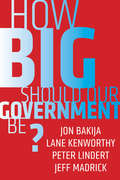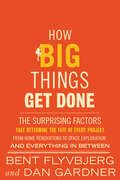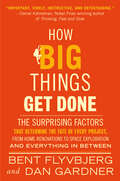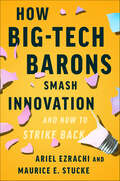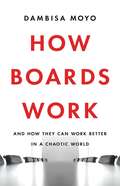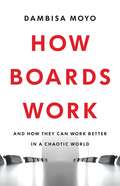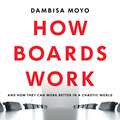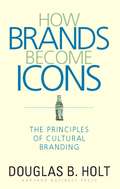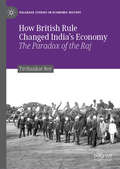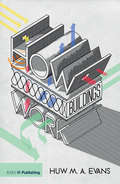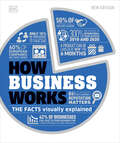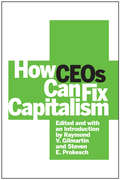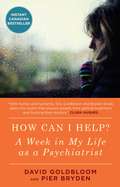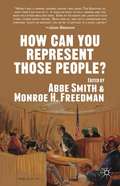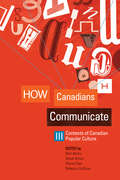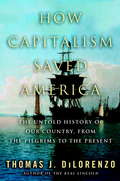- Table View
- List View
How Being Reasonable, Inspiring, or Diligent Can Inhibit Learning
by Chris Trimble Vijay GovindarajanChapters 7 and 8 show how the inevitable pressures associated with strategic experiments lead to well-intentioned actions that disable the learning process by altering aspirations, expectations, and judgments about performance. Chapter 8 analyzes the development of a new services business at Capston-White (not its real name), a large information technology company.
How Big Banks Fail and What to Do about It
by Darrell DuffieA leading finance expert explains how and why big banks fail—and what can be done to prevent itDealer banks—that is, large banks that deal in securities and derivatives, such as J. P. Morgan and Goldman Sachs—are of a size and complexity that sharply distinguish them from typical commercial banks. When they fail, as we saw in the global financial crisis, they pose significant risks to our financial system and the world economy. How Big Banks Fail and What to Do about It examines how these banks collapse and how we can prevent the need to bail them out.In sharp, clinical detail, Darrell Duffie walks readers step-by-step through the mechanics of large-bank failures. He identifies where the cracks first appear when a dealer bank is weakened by severe trading losses, and demonstrates how the bank's relationships with its customers and business partners abruptly change when its solvency is threatened. As others seek to reduce their exposure to the dealer bank, the bank is forced to signal its strength by using up its slim stock of remaining liquid capital. Duffie shows how the key mechanisms in a dealer bank's collapse—such as Lehman Brothers' failure in 2008—derive from special institutional frameworks and regulations that influence the flight of short-term secured creditors, hedge-fund clients, derivatives counterparties, and most devastatingly, the loss of clearing and settlement services.How Big Banks Fail and What to Do about It reveals why today's regulatory and institutional frameworks for mitigating large-bank failures don't address the special risks to our financial system that are posed by dealer banks, and outlines the improvements in regulations and market institutions that are needed to address these systemic risks.
How Big Should Our Government Be?
by Jeff Madrick Jon Bakija Lane Kenworthy Peter LindertThe size of government is arguably the most controversial discussion in United States politics, and this issue won't fade from prominence any time soon. There must surely be a tipping point beyond which more government taxing and spending harms the economy, but where is that point? In this accessible book, best-selling authors Jeff Madrick, Jon Bakija, Lane Kenworthy, and Peter Lindert try to answer whether our government can grow any larger and examine how we can optimize growth and fair distribution.
How Big Things Get Done: The Surprising Factors That Determine the Fate of Every Project, from Home Renovations to Space Exploration and Everything In Between
by Bent Flyvbjerg Dan GardnerThe secrets to successfully planning and delivering ambitious, complex projects on any scale—from home renovation to space exploration—by the world's leading expert on megaprojects.Nothing is more inspiring than a big vision that becomes a triumphant, new reality. Think of how the Empire State Building went from a sketch to the jewel of New York's skyline in twenty-one months, or how Apple&’s iPod went from a project with a single employee to a product launch in eleven months.These are wonderful stories. But most of the time big visions turn into nightmares. Remember Boston&’s &“Big Dig&”? Almost every sizeable city in the world has such a fiasco in its backyard. In fact, no less than 92% of megaprojects come in over budget or over schedule, or both. The cost of California&’s high-speed rail project soared from $33 billion to $100 billon—and won&’t even go where promised. More modest endeavors, whether launching a small business, organizing a conference, or just finishing a work project on time, also commonly fail. Why?Understanding what distinguishes the triumphs from the failures has been the life&’s work of Oxford professor Bent Flyvbjerg, dubbed &“the world&’s leading megaproject expert.&” In How Big Things Get Done, he identifies the errors in judgment and decision-making that lead projects, both big and small, to fail, and the research-based principles that will make you succeed with yours. For example:Understand your odds. If you don't know them, you won't win.Plan slow, act fast. Getting to the action quick feels right. But it's wrong. Think right to left. Start with your goal, then identify the steps to get there.Find your Lego. Big is best built from small.Be a team maker. You won't succeed without an "us."Master the unknown unknowns. Most think they can't, so they fail. Flyvbjerg shows how you can.Know that your biggest risk is you.Full of vivid examples ranging from the building of the Sydney Opera House, to the making of the latest Pixar blockbusters, to a home renovation in Brooklyn gone awry, How Big Things Get Done reveals how to get any ambitious project done—on time and on budget.
How Big Things Get Done: The Surprising Factors That Determine the Fate of Every Project, from Home Renovations to Space Exploration and Everything In Between
by Bent Flyvbjerg Dan Gardner&“Why do big projects go wrong so often, and are there any lessons you can use when renovating your kitchen? Bent Flyvbjerg is the &‘megaproject&’ expert and Dan Gardner brings the storytelling skills to How Big Things Get Done, with examples ranging from a Jimi Hendrix studio to the Sydney Opera House.&”—Financial Times &“Entertaining . . . There are lessons here for managers of all stripes.&”—The EconomistA BEST BOOK OF THE YEAR: Economist, Financial Times, CEO Magazine, MorningstarFinalist for the Porchlight Business Book Award, the Financial Times and Schroders Business Book of the Year Award, and the Inc. Non-Obvious Book AwardNothing is more inspiring than a big vision that becomes a triumphant, new reality. Think of how the Empire State Building went from a sketch to the jewel of New York&’s skyline in twenty-one months, or how Apple&’s iPod went from a project with a single employee to a product launch in eleven months.These are wonderful stories. But most of the time big visions turn into nightmares. Remember Boston&’s &“Big Dig&”? Almost every sizeable city in the world has such a fiasco in its backyard. In fact, no less than 92% of megaprojects come in over budget or over schedule, or both. The cost of California&’s high-speed rail project soared from $33 billion to $100 billon—and won&’t even go where promised. More modest endeavors, whether launching a small business, organizing a conference, or just finishing a work project on time, also commonly fail. Why?Understanding what distinguishes the triumphs from the failures has been the life&’s work of Oxford professor Bent Flyvbjerg, dubbed &“the world&’s leading megaproject expert.&” In How Big Things Get Done, he identifies the errors in judgment and decision-making that lead projects, both big and small, to fail, and the research-based principles that will make you succeed with yours. For example:• Understand your odds. If you don&’t know them, you won&’t win.• Plan slow, act fast. Getting to the action quick feels right. But it&’s wrong. • Think right to left. Start with your goal, then identify the steps to get there.• Find your Lego. Big is best built from small.• Be a team maker. You won&’t succeed without an &“us.&”• Master the unknown unknowns. Most think they can&’t, so they fail. Flyvbjerg shows how you can.• Know that your biggest risk is you.Full of vivid examples ranging from the building of the Sydney Opera House, to the making of the latest Pixar blockbusters, to a home renovation in Brooklyn gone awry, How Big Things Get Done reveals how to get any ambitious project done—on time and on budget.
How Big-Tech Barons Smash Innovation—and How to Strike Back
by Ariel Ezrachi Maurice E. StuckeTwo market experts deconstruct the drivers and inhibitors to innovation in the digital economy, explain how large tech companies can stifle disruption, assess the toll of their technologies on our well-being and democracy, and outline policy changes to take power away from big tech and return it to entrepreneurs.Silicon Valley’s genius combined with limited corporate regulation promised a new age of technological innovation in which entrepreneurs would create companies that would in turn fuel unprecedented job growth. Yet disruptive innovation has stagnated even as the five leading tech giants, which account for approximately 25 percent of the S&P 500’s market capitalization, are expanding to unimaginable scale and power. In How Big-Tech Barons Smash Innovation—and How to Strike Back, Ariel Ezrachi and Maurice E. Stucke explain why this is happening and what we can do to reverse it.While many distrust the Big-Tech Barons, the prevailing belief is that innovation is thriving online. It isn’t. Rather than disruptive innovations that create significant value, we are getting technologies that primarily extract value and reduce well-being. Using vivid examples and relying on their work in the field, the authors explain how the leading tech companies design their sprawling ecosystems to extract more profits (while crushing any entrepreneur that poses a threat). As a result, we get less innovation that benefits us and more innovations that surpass the dreams of yesteryears’ autocracies. The Tech Barons’ technologies, which seek to decode our emotions and thoughts to better manipulate our behavior, are undermining political stability and democracy while fueling tribalism and hate.But it’s not hopeless. The authors reveal that sustained innovation scales with cities not companies, and that we, as a society, should profoundly alter our investment strategy and priorities to certain entrepreneurs (“Tech Pirates”) and cities’ infrastructure.
How Boards Work: And How They Can Work Better in a Chaotic World
by Dambisa MoyoA New York Times bestselling author and veteran board member offers an insider's view of corporate boards, their struggles, and why they must adapt to survive. Corporate boards are under great pressure. Scandals and malpractice at companies like Theranos, WeWork, Uber, and Wells Fargo have raised justified questions among regulators, shareholders, and the public about the quality of corporate governance. In How Boards Work, prizewinning economist and veteran board director Dambisa Moyo offers an insider's view of corporate boards as they are buffeted by the turbulence of our times. Moyo argues that corporations need boards that are more transparent, more knowledgeable, more diverse, and more deeply involved in setting the strategic course of the companies they lead. How Boards Work offers a road map for how boards can steer companies through tomorrow's challenges and ensure they thrive to benefit their employees, shareholders, and society at large.
How Boards Work: And How They Can Work Better in a Chaotic World
by Dambisa Moyo'Highly instructive . . . provides thoughtful analysis' Financial Times'Exactly what any prospective-or sitting-board member needs' Arianna Huffington'A must read . . . highly engaging . . . an indispensable guide to how boards function, malfunction, and, most importantly, should operate better' Mohamed A. El-ErianCorporate boards are under great pressure. Scandals and malpractice at companies like GE, Theranos and WeWork have raised justified questions among regulators, shareholders, and the public about the quality of corporate governance. Boards face ever-louder demands to weigh in on questions of climate change, racial and gender equity, data privacy, and other social issues that range far beyond their traditional mandate: choosing the CEO and endorsing corporate strategy.In HOW BOARDS WORK, prizewinning economist, veteran board director, and bestselling author Dambisa Moyo offers an insider's view of corporate boards as they are buffeted by the turbulence of our times. Drawing on her decade of experience serving on corporate boards, Moyo lays out what it is that boards actually do, and she outlines how they must adapt to survive the challenges of coming years. Corporations need boards that are more transparent, more knowledgeable, more diverse, and more deeply involved in setting the strategic course of the companies they lead.HOW BOARDS WORK is an urgent road map for how boards can steer companies through tomorrow's challenges and ensure they thrive to benefit their employees, shareholders, and society at large.
How Boards Work: And How They Can Work Better in a Chaotic World
by Dambisa Moyo'Highly instructive . . . provides thoughtful analysis' Financial Times'Exactly what any prospective-or sitting-board member needs' Arianna Huffington'A must read . . . highly engaging . . . an indispensable guide to how boards function, malfunction, and, most importantly, should operate better' Mohamed A. El-ErianCorporate boards are under great pressure. Scandals and malpractice at companies like GE, Theranos and WeWork have raised justified questions among regulators, shareholders, and the public about the quality of corporate governance. Boards face ever-louder demands to weigh in on questions of climate change, racial and gender equity, data privacy, and other social issues that range far beyond their traditional mandate: choosing the CEO and endorsing corporate strategy.In HOW BOARDS WORK, prizewinning economist, veteran board director, and bestselling author Dambisa Moyo offers an insider's view of corporate boards as they are buffeted by the turbulence of our times. Drawing on her decade of experience serving on corporate boards, Moyo lays out what it is that boards actually do, and she outlines how they must adapt to survive the challenges of coming years. Corporations need boards that are more transparent, more knowledgeable, more diverse, and more deeply involved in setting the strategic course of the companies they lead.HOW BOARDS WORK is an urgent road map for how boards can steer companies through tomorrow's challenges and ensure they thrive to benefit their employees, shareholders, and society at large.
How Brands Become Icons
by D. B. HoltCoca-Cola. Harley-Davidson. Nike. Budweiser. Valued by customers more for what they symbolize than for what they do, products like these are more than brands--they are cultural icons. How do managers create brands that resonate so powerfully with consumers? Based on extensive historical analyses of some of America's most successful iconic brands, including ESPN, Mountain Dew, Volkswagen, Budweiser, and Harley-Davidson, this book presents the first systematic model to explain how brands become icons. Douglas B. Holt shows how iconic brands create "identity myths" that, through powerful symbolism, soothe collective anxieties resulting from acute social change. Holt warns that icons can't be built through conventional branding strategies, which focus on benefits, brand personalities, and emotional relationships. Instead, he calls for a deeper cultural perspective on traditional marketing themes like targeting, positioning, brand equity, and brand loyalty--and outlines a distinctive set of "cultural branding" principles that will radically alter how companies approach everything from marketing strategy to market research to hiring and training managers. Until now, Holt shows, even the most successful iconic brands have emerged more by intuition and serendipity than by design. With How Brands Become Icons, managers can leverage the principles behind some of the most successful brands of the last half-century to build their own iconic brands. Douglas B. Holt is associate professor of Marketing at Harvard Business School.
How Breakthroughs Happen: The Surprising Truth About How Companies Innovate
by Andrew HargadonThis book presents lessons from the famous 'Invention Factories' past and present. Did you know that the incandescent lightbulb first emerged some thirty years before Thomas Edison famously 'turned night into day'? Or that Henry Ford's revolutionary assembly line came from an unlikely blend of observations from Singer sewing machines, meatpacking, and Campbell's Soup? In this fascinating study of innovation, engineer and social scientist Andrew Hargadon argues that our romantic notions about innovation as invention are actually undermining our ability to pursue breakthrough innovations. Based on ten years of study into the origins of historic inventions and modern innovations from the lightbulb to the transistor to the Reebok Pump athletic shoe, How Breakthroughs Happen takes us beyond the simple recognition that revolutionary innovations do not result from flashes of brilliance by lone inventors or organizations. In fact, innovation is really about creatively recombining ideas, people, and objects from past technologies in ways that spark new technological revolutions. This process of 'technology brokering' is so powerful, explains Hargadon, because it exploits the networked nature—the social side—of the innovation process. Moving between historical accounts of labs and factory floors where past technological revolutions originated and field studies of similar processes in today's organizations, Hargadon shows how technology brokers create an enduring capacity for breakthrough innovations. Technology brokers simultaneously bridge the gaps in existing networks that separate distant industries, firms, and divisions to see how established ideas can be applied in new ways and places, and build new networks to guide these creative recombinations to mass acceptance. How Breakthroughs Happen identifies three distinct strategies for technology brokering that managers can implement in their organizations. Hargadon suggests that Edison and his counterparts were no smarter than the rest of us-they were simply better at moving through the networked world of their time. Intriguing, practical, and counterintuitive, How Breakthroughs Happen can help managers transform their own firms into modern-day invention factories.
How British Rule Changed India’s Economy: The Paradox of the Raj (Palgrave Studies in Economic History)
by Tirthankar RoyThis Palgrave Pivot revisits the topic of how British colonialism moulded work and life in India and what kind of legacy it left behind. Did British rule lead to India’s impoverishment, economic disruption and famine? Under British rule, evidence suggests there were beneficial improvements, with an eventual rise in life expectancy and an increase in wealth for some sectors of the population and economy, notably for much business and industry. Yet many poor people suffered badly, with agricultural stagnation and an underfunded government who were too small to effect general improvements. In this book Roy explains the paradoxical combination of wealth and poverty, looking at both sides of nineteenth century capitalism. Between 1850 and 1930, India was engaged in a globalization process not unlike the one it has seen since the 1990s. The difference between these two times is that much of the region was under British colonial rule during the first episode, while it was an independent nation state during the second. Roy's narrative has a contemporary relevance for emerging economies, where again globalization has unleashed extraordinary levels of capitalistic energy while leaving many livelihoods poor, stagnant, and discontented.
How Buildings Work
by Huw M EvansAn understanding of building physics is fundamental for the design and construction of safe, functional, energy efficient buildings. Without it, occupants’ health and comfort is compromised, energy bills become unmanageable, or the building fabric itself can fail. But it’s not just about providing a heating source or stopping the cold coming in; at the heart of building physics is a fine balancing act: how much ventilation will be required for the occupants and how can that be provided without compromising the thermal performance? How will the layout and fenestration affect light levels and cooling demand? How Buildings Work provides construction professionals with a clear understanding of the basic mechanisms of physics and how they affect the performance and operation of buildings. Heat, air, moisture, sound, light and radioactivity are explained in turn, yet all the while reminding the reader that none of these phenomena can be considered in isolation when designing a building. Whether you’re a student trying to get your head round the basics, or a seasoned practitioner looking for a quick refresher course.
How Business Works (DK How Stuff Works)
by DKLearn the essentials of business, finance, and company management with this unique graphic guide from DK!If you're perplexed by profit margins, confused by cash flow, or baffled by balance sheets, all your questions and many more are answered in this indispensable business book. Get to grips with how companies work, from research and development, to sales and marketing, and production and distribution.Eye-catching visual aids give a helpful representation of each and every aspect of business, while complex subjects are broken down into concise explanations, expressed in easy-to-understand language. Crammed with essential terms and key concepts, How Business Works is perfect for anyone looking to take their business to the next level, or those learning the ropes from the ground to the top.Within this one-stop guide you will find:-Hundreds of colorful images and engaging graphics.-Demystifying explanations of complex theories and financial jargon.-Up-to-date guidance on remote and flexible business strategies.-Comprehensive information about international business practice, equipping you with the skills to tackle the global marketplace.Whether you're launching a startup, having trouble managing stakeholder relationships, or simply interested in all things business, you wont find a more comprehensive guide than this! Much more than a standard business management or self help book, How Business Works shows you what other titles only tell you, combining solid reference with no-nonsense advice.Having trouble adjusting to our working from home business culture? This new and improved edition includes the latest tips and techniques to help you stay motivated and achieve the best possible results while working remotely.Reach new heights of personal development!Take your learning to the next level with How Management Works and How to Start Your Own Business - the perfect learning companions to accompany this practical business reference book. Want to stretch your brain even further? Discover DK's extremely successful How ... works series, a curated collection of more than a dozen graphic reference books covering topics from psychology, to technology and music, and many more!
How CEOs Can Fix Capitalism
by Steven E. Prokesch Raymond V. GilmartinThe financial crisis of 2008 and the Great Recession caused a crisis of public confidence in business and American-style capitalism, with its focus on maximizing shareholder value. Corporate leaders understood that reform was needed and that they needed to commit themselves to the dual goal of producing benefits for society and their firms' bottom lines-to creating "shared value." But the specific actions they could take to bring about this change were less clear. This ebook offers some of the freshest thinking today on practical measures that businesses can implement to create shared value. Originally published in an online forum hosted by Harvard Business Review, it offers valuable advice about how CEOs, other senior executives, and boards of directors can work together to engage stakeholders in new ways, change their companies' values, build healthier relationships with investors, revamp incentive systems to create long-term value, and develop stronger succession plans.The authors of this collection of short articles include current or former CEOs, such as Howard Schultz of Starbucks and Dominic Barton of McKinsey & Company, and an array of prominent academics and other thought leaders, including Roger Martin of the University of Toronto, Jeffrey Pfeffer of Stanford, and Alfred Rappaport of Northwestern.Its editors are Raymond Gilmartin, the former CEO of Merck and, until recently, an adjunct professor at Harvard Business School, and Steve Prokesch, a senior editor at Harvard Business Review who previously worked at the New York Times and BusinessWeek magazine. In their introduction, they offer five specific recommendations on how CEOs can restore public faith in capitalism.HBR Singles provide brief yet potent business ideas, in digital form, for today's thinking professional.
How COVID-19 is Accelerating the Digital Revolution: Challenges and Opportunities
by G. Suseendran Uttam Ghosh Noor Zaman Jhanjhi R. Anandan Pushpita ChatterjeeThis book explores how digital technologies have proved to be a useful and necessary tool to help ensure that local and regional governments on the frontline of the emergency can continue to provide essential public services during the COVID-19 crisis. Indeed, as the demand for digital technologies grows, local and regional governments are increasingly committed to improving the lives of their citizens under the principles of privacy, freedom of expression and democracy.The Digital Revolution began between the late 1950s and 1970s and represents the evolution of technology from the mechanical and analog to the digital. The advent of digital technology has also changed how humans communicate – today using computers, smartphones and the internet. Further, the digital revolution has made a tremendous wealth of information accessible to virtually everyone. In turn, the book focuses on key challenges for local and regional governments concerning digital technologies during this crisis, e.g. the balance between privacy and security, the digital divide, and accessibility. Privacy is a challenge in the mitigation of COVID-19, as governments rely on digital technologies like contact-tracking apps and big data to help trace peoples’ patterns and movements. While these methods are controversial and may infringe on rights to privacy, they also appear to be effective measures for rapidly controlling and limiting the spread of the virus. Next, the book discusses the 10 technology trends that can help build a resilient society, as well as their effects on how we do business, how we work, how we produce goods, how we learn, how we seek medical services and how we entertain ourselves. Lastly, the book addresses a range of diversified technologies, e.g. Online Shopping and Robot Deliveries, Digital and Contactless Payments, Remote Work, Distance Learning, Telehealth, Online Entertainment, Supply Chain 4.0, 3D Printing, Robotics and Drones, 5G, and Information and Communications Technology (ICT).
How Can Burundi Raise Its Growth Rate?
by Olivier BasdevantA report from the International Monetary Fund.
How Can Great Firms Fail? Insights from the Hard Disk Drive Industry
by Clayton M. ChristensenThe disk drive industry is ideal for studying patterns of business failure, because rich data exist about it and because it has a particularly fast life cycle. In a matter of a few years, market segments, companies, and technologies emerge, mature, and decline. Companies with apparently sound management practices fall prey to disruptive innovators who grab their market share and precipitate their decline. This chapter outlines the history of the industry and shows how new entrants to the industry repeatedly unseat incumbents. This chapter was originally published as chapter 1 of "The Innovator's Dilemma: When New Technologies Cause Great Firms to Fail."
How Can I Help?: A Week in My Life as a Psychiatrist
by David Goldbloom Pier Bryden, M.D.A humane behind-the-scenes account of a week in the life of a psychiatrist at one of Canada’s leading mental health hospitals. How Can I Help? takes us to the frontlines of modern psychiatric care.How Can I Help? portrays a week in the life of Dr. David Goldbloom as he treats patients, communicates with families, and trains staff at CAMH, the largest psychiatric facility in Canada. This highly readable and touching behind-the-scenes account of his daily encounters with a wide range of psychiatric concerns—from his own patients and their families to Emergency Department arrivals—puts a human face on an often misunderstood area of medical expertise. From schizophrenia and borderline personality disorder to post-traumatic stress syndrome and autism, How Can I Help? investigates a range of mental issues. What is it like to work as a psychiatrist now? What are the rewards and challenges? What is the impact of the suffering—and the recovery—of people with mental illness on families and the clinicians who treat them? What does the future hold for psychiatric care? How Can I Help? demystifies a profession that has undergone profound change over the past twenty-five years, a profession that is often misunderstood by the public and the media, and even by doctors themselves. It offers a compassionate, realistic picture of a branch of medicine that is entering a new phase, as increasingly we are able to decode the mysteries of the brain and offer new hope for sufferers of mental illness.
How Can We Beat Our Most Powerful Competitors?
by Clayton M. Christensen Michael E. RaynorHow can we beat our most powerful competitors? What strategies will result in those competitors getting the upper hand instead? This chapter addresses these and other questions, focusing on the disruptive innovation model to help growth-builders shape their strategies and pick disruptive fights they can win. An appendix is included that summarizes the disruptive roots of success for a number of companies, such as Amazon.com, Dell Computers, and Merrill Lynch.
How Can We Explain Black Support For Donald Trump?: The Impact of Black Identity and Religiosity on Black Voting Patterns (Springer Series in Electoral Politics)
by Kofi ArhinAfrican Americans have long been the backbone of the Democratic Party. Yet, the rise of Donald Trump, with his radical Republican stance, did not diminish their support for him compared to previous Republican candidates. This book analyzes an intriguing question: Why are some African American voters not deterred by Trump’s rhetoric? Exploring a new theory, the book argues that Black Trump voters have varying degrees of attachment to Black identity. Those with weaker ties to Black identity are less likely to conform to the expected political behavior of their community. Instead, their primary identity, often Christianity, guides their voting decisions. This shift in identity prioritization leads them to support the Republican Party, regardless of the candidate. This book provides a fresh perspective on race, identity, and political allegiance in contemporary America. It will appeal to students, scholars, and researchers of political science in general and electoral studies in particular.
How Can You Represent Those People?
by Abbe Smith Monroe H. FreedmanHow Can You Represent Those People? is the first-ever collection of essays offering a response to the 'Cocktail Party Question' asked of every criminal lawyer. Contributors include prominent lawyers and rising stars, each offering a different often very personal perspective on the Question. Many share stories comic and tragic, inspiring and heartbreaking about criminal defense. Contributors include public defenders, capital defenders, prisoners' rights lawyers, and academics. Essays discuss clients ranging widely from 'ordinary' indigent defendants to alleged terrorists. This is a fascinating collection, a must-read for anyone interested in race, poverty, crime, punishment, and what makes lawyers tick. "
How Canadians Communicate III
by Bart Beaty Derek Briton Gloria FilaxContexts of Canadian Popular Culture
How Capitalism Saved America: The Untold History of Our Country from the Pilgrims to the Present
by Thomas J. DilorenzoWhether it's Michael Moore or the New York Times, Hollywood or academia, a growing segment in America is waging a war on capitalism. We hear that greedy plutocrats exploit the American public; that capitalism harms consumers, the working class, and the environment; that the government needs to rein in capitalism; and on and on. Anticapitalist critiques have only grown more fevered in the wake of corporate scandals like Enron and WorldCom. Indeed, the 2004 presidential campaign has brought frequent calls to re-regulate the American economy. But the anticapitalist arguments are pure bunk, as Thomas J. DiLorenzo reveals in How Capitalism Saved America. DiLorenzo, a professor of economics, shows how capitalism has made America the most prosperous nation on earth--and how the sort of government regulation that politicians and pundits endorse has hindered economic growth, caused higher unemployment, raised prices, and created many other problems. He propels the reader along with a fresh and compelling look at critical events in American history--covering everything from the Pilgrims to Bill Gates. And just as he did in his last book, The Real Lincoln, DiLorenzo explodes numerous myths that have become conventional wisdom. How Capitalism Saved America reveals: * How the introduction of a capitalist system saved the Pilgrims from starvation * How the American Revolution was in large part a revolt against Britain's stifling economic controls * How the so-called robber barons actually improved the lives of millions of Americans by providing newer and better products at lower prices * How the New Deal made the Great Depression worse * How deregulation got this country out of the energy crisis of the 1970s--and was not the cause of recent blackouts in California and the Northeast * And much more How Capitalism Saved America is popular history at its explosive best.
How Capitalism Underdeveloped Black America
by Manning MarableThis book records the respective histories of the different social strata within Black political economy and society.


